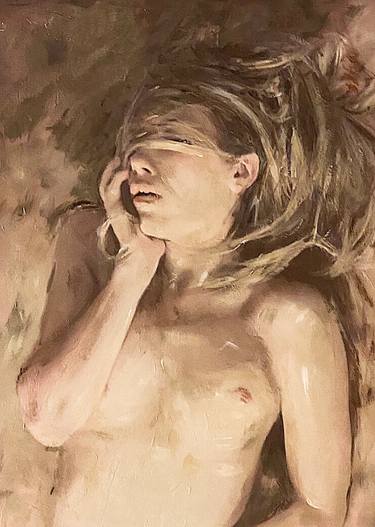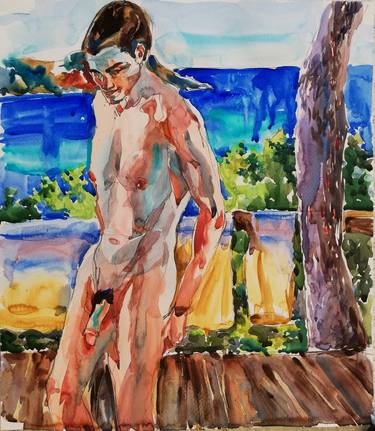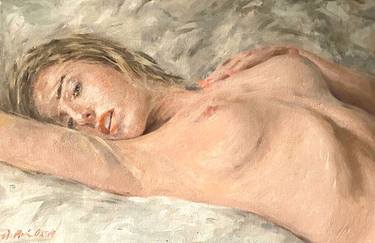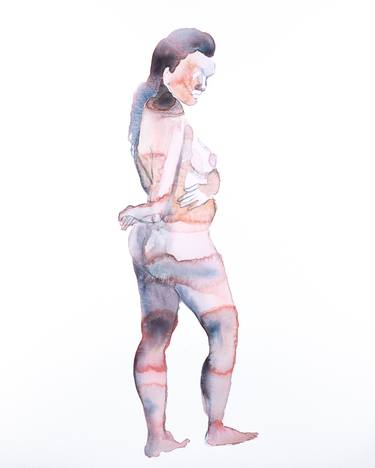Nude Paintings For Sale
Browse art and see similar matches
Try Visual Search
Category
Filter (1)
Filter
Category
Style
Subject
Medium
Material
Price
Size
Orientation
Color
Artist Country
Featured Artist
Paintings, 47.2 W x 59.1 H x 0.4 D in
Poland
$1,970
Prints from $40
Paintings, 11 W x 15 H x 0.1 D in
United States
$310
Prints from $40
Paintings, 3.9 W x 4.3 H x 0.4 D in
Hungary
$180
Prints from $80
SERENDIPITY / NUDE 102 CM X 72 CM LARGE MODERN ART
Paintings, 28.3 W x 40.2 H x 0.1 D in
Ireland
$1,270
'Crystal Clear The Waters Flow'
Paintings, 12 W x 16 H x 1 D in
United Kingdom
$1,590
Prints from $69
Paintings, 9 W x 12 H x 0.1 D in
United States
$150
Prints from $40
Paintings, 27.6 W x 37 H x 0.1 D in
United Kingdom
$1,445
Paintings, 12.7 W x 16.6 H x 0.1 D in
Serbia
$239
Prints from $69
Paintings, 18 W x 16 H x 0.1 D in
United States
$310
Prints from $40
Paintings, 14.2 W x 16.3 H x 0.1 D in
Serbia
$454
Prints from $57
Paintings, 14.8 W x 11.8 H x 0.1 D in
France
$790
Paintings, 20 W x 24 H x 0.5 D in
United States
$1,350
Prints from $51
Paintings, 15.5 W x 19.7 H x 0.1 D in
Serbia
$475
Paintings, 39.4 W x 31.9 H x 0.6 D in
Spain
$2,770
Prints from $53
Paintings, 15.7 W x 23.6 H x 0.8 D in
Belgium
$1,435
Prints from $51
Paintings, 11.4 W x 16.1 H x 0.1 D in
France
$255
Prints from $40
Paintings, 24 W x 18 H x 0.1 D in
United States
$390
Prints from $40
Paintings, 20.9 W x 31.5 H x 0.1 D in
United Kingdom
$2,610
Prints from $40
Paintings, 39.4 W x 51.2 H x 1 D in
Spain
$2,240
Paintings, 7.9 W x 11.8 H x 0.1 D in
Argentina
$600
Paintings, 31.5 W x 47.2 H x 5.1 D in
Poland
$6,700
Paintings, 12 W x 16 H x 1 D in
United Kingdom
$1,390
Prints from $100
Paintings, 19.7 W x 27.6 H x 0.1 D in
Argentina
$1,910
Prints from $40
Paintings, 18.5 W x 21.7 H x 0.8 D in
Romania
$1,750
Prints from $100
Paintings, 28 W x 38.2 H x 0.1 D in
United Kingdom
$2,840
Prints from $95
Paintings, 35.4 W x 39.4 H x 2 D in
Germany
$11,340
Paintings, 12.8 W x 17.8 H x 0.1 D in
Serbia
$269
Prints from $66
Paintings, 31.5 W x 39.4 H x 0.8 D in
Italy
$3,300
Prints from $40
Paintings, 11.8 W x 15.5 H x 0.1 D in
Serbia
$276
Prints from $49
Paintings, 33.5 W x 35.4 H x 0.4 D in
United Kingdom
$3,860
Prints from $125
Paintings, 15.7 W x 15.7 H x 1.6 D in
Saint Martin
$1,170
Prints from $100
Paintings, 44.9 W x 30.3 H x 0.8 D in
Italy
$2,030
Paintings, 93 W x 59 H x 1.5 D in
South Korea
$6,970
Paintings, 11.8 W x 15.7 H x 0.2 D in
Argentina
$1,000
Paintings, 19.6 W x 28.6 H x 0.8 D in
South Korea
$3,660
Prints from $40
Paintings, 25.6 W x 36.2 H x 0.8 D in
France
$1,570
Prints from $43
Paintings, 16 W x 12 H x 1 D in
United Kingdom
$1,590
Prints from $68
Paintings, 19.7 W x 23.6 H x 1.6 D in
New Zealand
$4,670
Rueckenakt - Nude backportrait
Paintings, 27.6 W x 29.5 H x 0.8 D in
Germany
$3,610
Paintings, 13.9 W x 17.7 H x 0.1 D in
Serbia
$339
Prints from $63
Paintings, 31.5 W x 39.4 H x 1.2 D in
Spain
$2,430
Paintings, 16 W x 20 H x 0.1 D in
United States
$380
Prints from $40
Paintings, 7.1 W x 9.8 H x 0.4 D in
Hungary
$229
Prints from $80
A linear sensation of light and color.
Paintings, 14.6 W x 11 H x 0.4 D in
Mexico
$650
Prints from $100
Paintings, 19.7 W x 23.6 H x 0.8 D in
Spain
$1,260
Paintings, 11.4 W x 16.1 H x 0.1 D in
France
$180
Prints from $40
Paintings, 59.1 W x 39.4 H x 0.8 D in
Italy
$8,140
Prints from $50
Paintings, 39.4 W x 59.1 H x 0.4 D in
Saint Martin
$4,670
Prints from $100
Paintings, 26.4 W x 33.5 H x 2 D in
Ukraine
$880
Prints from $40
Paintings, 19.7 W x 25.6 H x 0.1 D in
France
$560
Prints from $95













































